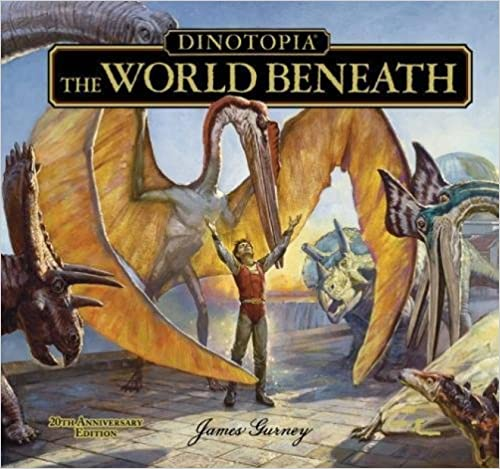Dinotopia: The World Beneath – An Illustrated Journey into a Hidden Civilization
Explore Dinotopia: The World Beneath, a richly illustrated sequel by James Gurney—discover its plot, characters, themes, and legacy in this in-depth guide.

Introduction to Dinotopia and Its Sequel
When James Gurney released "Dinotopia: A Land Apart from Time" in 1992, readers were captivated by its breathtaking paintings and hopeful vision of humans and dinosaurs living together in harmony. The book’s success inevitably begged for more adventures, and in 1995 Gurney delivered with "Dinotopia: The World Beneath." This lavishly illustrated sequel expands the mythos of the island, takes heroes Arthur and Will Denison into subterranean realms, and deepens the environmental themes that made the original a classic. Whether you are a longtime fan of the series or a newcomer curious about its enduring appeal, understanding what makes this second volume special will enhance your appreciation of both the artwork and the story.
Plot Overview of The World Beneath
The narrative picks up shortly after the events of the first book. Professor Arthur Denison, now a respected explorer among Dinotopians, theorizes that the island’s steam-powered Skybax hang gliders and myriad mechanical wonders stem from an ancient technology hidden underground. He and Bix, the steadfast Protoceratops who serves as translator and friend, organize an expedition to seek the fabled lost city of Poseidos and the mysterious sun-stone power source rumored to be buried in "The World Beneath." Meanwhile, Arthur’s son Will embarks on a separate journey to perfect his Skybax piloting skills, providing a thrilling airborne subplot that intersects with Arthur’s adventure at pivotal moments.
A Tale of Two Journeys
Gurney cleverly alternates chapters between these parallel quests, creating a rhythmic sense of momentum. Arthur’s party must navigate labyrinthine caverns, avoid bioluminescent predators, and decipher glyphs left by the ancient Poseidans. Will, for his part, contends with turbulent air currents above the Rainy Basin and the occasional hungry pterosaur. Both arcs converge when father and son discover that the energy crystals they seek are both the key to Dinotopia’s prosperity and a potential catalyst for catastrophe should they fall into the wrong hands.
Key Characters and New Dinosaurs
In addition to familiar faces like Bix and the matriarchal dinosaur elder, Oriana, the sequel introduces a host of memorable characters. Lee Crabb, the duplicitous outsider from the first book, returns with his own agenda, representing the seductive lure of exploitation. On the dinosaur side, readers meet Tera, a bright-eyed Oviraptor adept at stone-carving, and Nimbus, a courageous Quetzalcoatlus who guides Will through perilous skies. Each new creature is rendered with Gurney’s signature, museum-quality realism, lending credibility to a fantastical premise.
Illustrations That Bring the Underground to Life
While the original Dinotopia dazzled with sunlit waterfalls and coral-colored cities, "The World Beneath" showcases an entirely different palette. Luminescent fungi light mossy caverns, crystal clusters refract alien rainbows, and mechanical relics lie half-buried in silt. Gurney’s oil paintings, often spanning two full pages, invite readers to linger on every stalactite and fossil. The rich visuals are not mere decoration; they reveal clues to the storyline, such as the way ancient glyphs mirror shapes found in living dinosaur feathers. Collectors often cite this volume as the most ambitious in the series because of its dramatic lighting and complex perspective work.
Themes: Sustainability, Cooperation, and Responsible Technology
Underneath the page-turning adventure lies a thoughtful meditation on sustainability. The sun-stones, essentially a limitless clean-energy source, symbolize humankind’s potential for both creation and destruction. Arthur’s insistence on learning from the past rather than exploiting it contrasts sharply with Lee Crabb’s greedy designs. By showing dinosaurs and humans debating ethics in council chambers, Gurney reinforces a core Dinotopian principle: survival depends on cooperative stewardship of resources. These ethical quandaries feel remarkably prescient in today’s climate-conscious era, making the book more than mere escapism.
Reading Order and Accessibility
Although "The World Beneath" is officially the second book, it can be enjoyed as a standalone adventure. Gurney provides enough contextual footnotes—styled as entries in Arthur’s field journal—to ensure new readers are never lost. However, starting with the first volume enriches the emotional stakes, particularly the father-son dynamic and the evolution of Will’s relationship with his Skybax partner, Cirrus. For younger readers or those daunted by traditional novels, the large format, cutaway diagrams, and digestible blocks of text make the book highly accessible.
Critical Reception and Awards
Upon release, "The World Beneath" spent twelve weeks on The New York Times bestseller list and earned the Hugo Award nomination for Best Original Artwork. Critics praised Gurney’s ability to blend scientific rigor with whimsical storytelling, noting his background as an illustrator for National Geographic. Teachers and librarians quickly adopted the book for its cross-curricular potential, spanning literature, art, and natural history. Today, nearly three decades later, second-hand copies remain in high demand, a testament to the story’s timeless allure.
Adaptations and Cultural Impact
The wider Dinotopia franchise includes a TV miniseries, graphic novels, and a video game, but none capture the subterranean majesty depicted in "The World Beneath." Cosplayers routinely recreate Arthur’s steampunk-inspired diving suit, while paleontology outreach programs reference Gurney’s speculative biology to spark children’s interest in real dinosaurs. Even professional concept artists cite the book as an influence on blockbuster films, from "Avatar" to "How to Train Your Dragon." In many ways, Gurney’s vision helped normalize the idea of dinosaurs as complex, feathered beings long before the scientific consensus did the same.
Tips for Collectors and New Readers
First-edition hardcovers retain the highest value, especially those signed by Gurney at one of his popular painting workshops. However, recent 20th-anniversary reprints use updated color profiles that arguably showcase the art even better. Digital editions are serviceable, but the tactile experience of turning oversized pages remains unmatched. If you are introducing a young reader to Dinotopia, consider pairing the book with a map poster so they can track Arthur and Will’s routes through the underworld.
Final Thoughts: Why The World Beneath Still Matters
"Dinotopia: The World Beneath" endures because it marries pulse-pounding exploration with a gentle, optimistic philosophy. In an era often dominated by dystopian narratives, Gurney invites us instead to imagine a balanced society where technological prowess aligns with ecological wisdom. The book’s underground vistas remind us that the greatest treasures—whether sun-stones or new ideas—are worth safeguarding. If you have ever gazed at a museum fossil and wondered what might have been, this richly imagined journey will kindle your sense of wonder anew.



